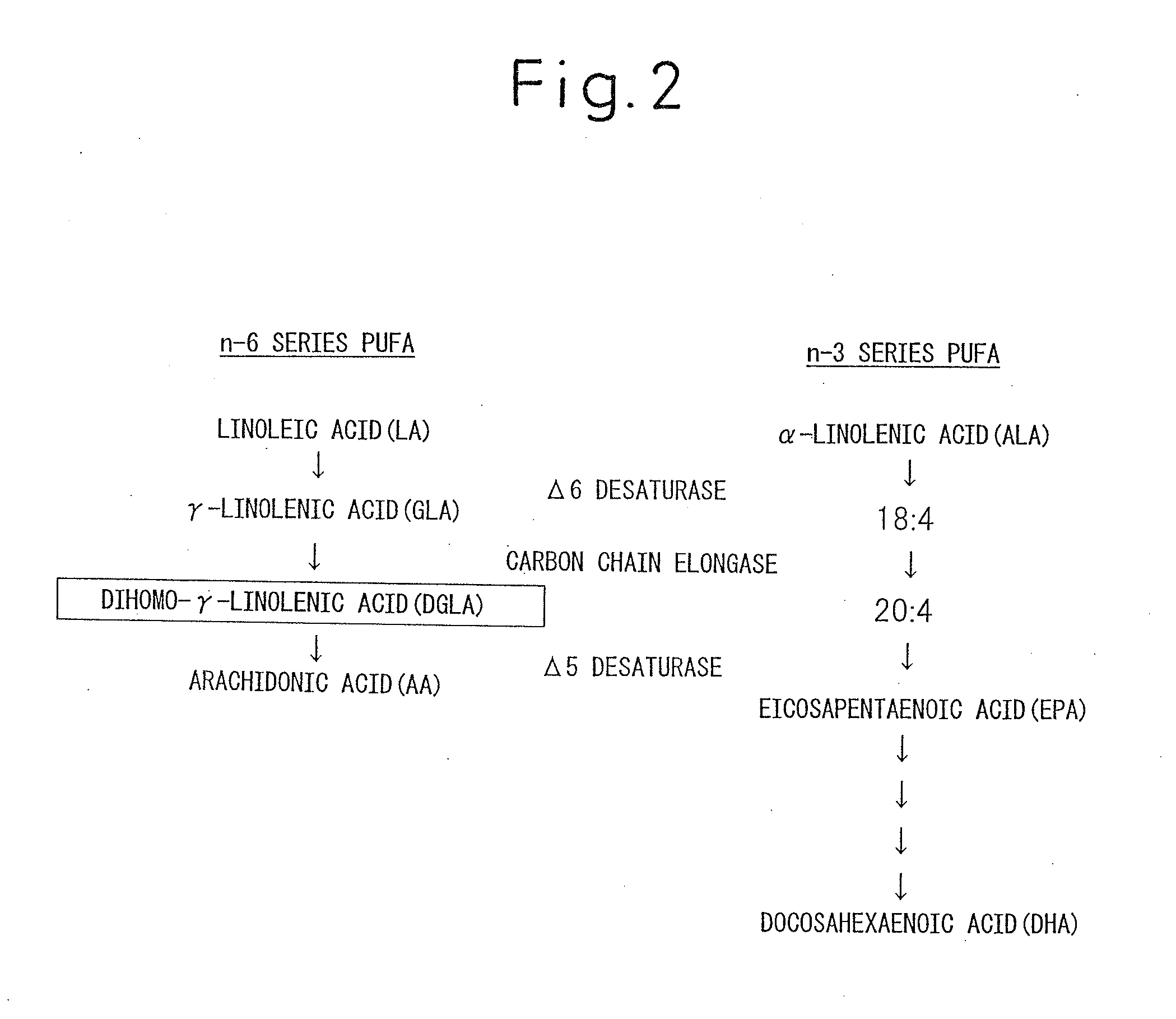COMPOSITION CONTAINING DIHOMO-y-LINOLENIC ACID (DGLA) AS THE ACTIVE INGREDIENT
a technology of dihomoylinolenic acid and active ingredient, which is applied in the field of food ingredients, can solve the problems of skin scale, increased moisture loss and the like, and specific abnormal skin functions, and achieve the effect of more safely and effectively preventing and treating atopic dermatitis
- Summary
- Abstract
- Description
- Claims
- Application Information
AI Technical Summary
Benefits of technology
Problems solved by technology
Method used
Image
Examples
example 1
[0129]Since it was believed that ingestion of DGLA is useful for the prevention or treatment of atopic dermatitis, as described above, its usefulness in experimental animals was investigated using a triglyceride SUNTGD, a DGLA lipid having DGLA as the main constituent fatty acid, that was prepared according to the method described in U.S. Pat. No. 3,354,581. As an animal model of atopic dermatitis, NC / Nga mice were used in this study. Since mice have been recognized as one of the most useful models of atopic dermatitis at present, and steroid external preparations and immunosuppressive external preparations currently used in the clinical setting for the treatment of atopic dermatitis have also been demonstrated to be effective in mice it has widely been used in screening of therapeutic agents for atopic dermatitis.
[0130]In a conventional feeding environment, mice are known to spontaneously develop dermatitis at about 8 weeks after birth, and then the inflammation aggravates to a chr...
example 2
[0135]In order to clarify the relationship between the amount of DGLA orally ingested in humans and the internal DGLA level, the amount of DGLA orally ingested was investigated by examination of the diet, and after drawing blood, the amount of DGLA in the serum phospholipids was determined. The subjects were eleven healthy males aged 60-70, and were asked to keep a diary of the content of their diets. From the diary, the amount ingested by each food material was determined for meat, eggs, and seafood known to contain DGLA, and using the DGLA content of each food material calculated from “Fourth revised STANDARD TABLES OF FOOD COMPOSITION IN JAPAN, Standard Tables of Dietary Lipids in Japan (1990)”, the amount ingested of DGLA per day per person was calculated. From the amount of DGLA ingested per week, the mean amount of DGLA ingested per day was calculated for each person.
[0136]On the other hand, blood was drawn the day after the last entry of the diary, and for the serum phospholi...
example 3
[0139]For some skin diseases, it is known that the skin may be damaged by sunlight. Specifically, ultraviolet light classified as UV-B at wavelengths of 290-320 nm is considered a major factor responsible for acute sunburn of the skin, pigmentation, suntan, skin cancer and the like. In order to explore the further possibility of DGLA affecting skin function, the effect of DGLA on acute inflammation of the skin was evaluated using an UV-B-induced acute inflammation guinea pig model. This model animal is one model widely used for drug screening in the development of pharmaceutical agents intended for anti-inflammatory effects.
[0140]In this study, male Hartley guinea pigs were prepared and divided into a control diet group and a DGLA diet group. Each diet group was continued to be given ad libitum for three weeks, from 5 week-old to 7 week-old animals, at the completion of the experiment. The DGLA diet used this time is different from the composition of the mouse diet described earlier...
PUM
 Login to View More
Login to View More Abstract
Description
Claims
Application Information
 Login to View More
Login to View More - R&D
- Intellectual Property
- Life Sciences
- Materials
- Tech Scout
- Unparalleled Data Quality
- Higher Quality Content
- 60% Fewer Hallucinations
Browse by: Latest US Patents, China's latest patents, Technical Efficacy Thesaurus, Application Domain, Technology Topic, Popular Technical Reports.
© 2025 PatSnap. All rights reserved.Legal|Privacy policy|Modern Slavery Act Transparency Statement|Sitemap|About US| Contact US: help@patsnap.com


